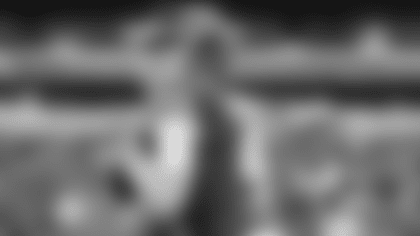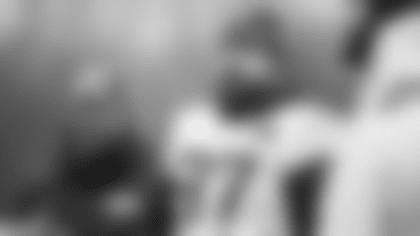Transcript of head coach Eric Mangini's news conference with the New York Jets media after Friday afternoon's minicamp practice:
I'd like to welcome everybody back. I know it's been a while, but this is a great time of year. All the hard work that we put in and organizationally put into the draft, so many people working on it throughout the whole off-season, and really, the whole year, meeting as many players as we've met, interviewing as many players as we have, evaluating them, then you get the picks and then bring these guys in, the undrafted free agents that we've signed to contracts, the tryout players that are here — to get all of these guys on the field and to start working on football again is always an exciting time.
We have a couple of new coaches working out there as well. To see them in action, outside of the classroom, that's always fun. It helps kick off the season, being on the field. Always, always a great time of year.
On players that stood out in practice …
It's really early and usually, over the course of the weekend, someone will stand out one way or the other, positively or negatively. That's something we talk a lot about. I talk a lot about it with the players, that the important thing is that they are in the room and they have this opportunity. I think it's one out of a thousand kids that play high school football get a chance in the NFL or to play NFL football, so they have already defied the odds being here. Now we have guys like Wallace Wright, who came in as a rookie and a tryout player similar to a lot of these guys, and he's been here and done a really nice job for us. We've seen that spectrum of guys over the years. We'll just see who distinguishes themselves.
On whether he tells the rookies about success stories from past years …
Yes, we go through the top-round guys that haven't had very successful NFL careers and the undrafted free agents that have had really successful careers. [Assistant strength and conditioning coach] Rick Lyle was an undrafted free agent and played for 10 years. Tony Richardson, he was an undrafted free agent and he's still playing. The list goes on and on. There are some great ones that never had a chance to be drafted.
On criticism of Vernon Gholston …
As you go through the process, you can find things to look at that may not be as positive. These are all incredibly talented players that have had extremely successful careers. Part of the process is trying to identify the positives and the negatives. With Vernon, I really liked the things I saw on tape. I liked the way he was able to set the edge, the way he affected the quarterback. I like the fact that I was able to see him drop into coverage, and not just drop in coverage but be part of rush schemes that combined the interior lines and the linebacker where he had to blitz-peel on a running back coming out.
You saw all those elements, things like him playing the option, whether it was the quarterback or the pitch man, and having to sit on the back side. Some of those things you could look at where it was definitely a situation that he had back side, not contain, but he had that element of the defense. Those things are plays that also show a lot of discipline, because if you do run too quickly to the other side, you can give up the cutback lane, a reverse, things along those lines. Working through the defenses and seeing the defenses, I was appreciating the things he was asked to do. I felt very good about it.
On the time spent talking to Gholston and his transition from DE to LB …
We spent a lot of time on his visit. Mike [Tannenbaum] spent some time with him individually at Ohio State as well. We've been through a lot of the position changes. End to outside linebacker, that's usually the way it goes. Guys sometimes go from end to inside linebacker. It's going to be a learning curve, and that's what I liked about the things he did at Ohio State. You saw him drop and you saw him have to be involved with the blitz peel and elements like that. So it's not a complete projection. You've seen those things on tape.
On following Gholston last season …
No, I didn't follow him last fall. I didn't get to watch a lot of college football last year.
On how early he began to watch video on Gholston …
I was on the treadmill. It was pretty soon after the season. I remember watching him while I was on the treadmill. I know how that may seem shocking at this point, but I was actually on the treadmill [laughs].
On if he was actually walking on the treadmill …
No, I was just standing there having dinner. [Laughter] But I wanted to say that I got on the treadmill.
So you were doing your thing on the treadmill ...
I was watching the tape and I remember thinking, "This could be the sixth pick in the draft."
On when this was …
It was pretty soon after the season.
On thinking Gholston could be a early pick …
I remember going to my office afterwards and looking the guy up on Prodigy, our system. It kind of worked out [smiles.]
On what stood out about Gholston …
It was all those things that I talked about — the strength on the edge, his ability to rush the passer and the number of sacks. You see, obviously, a good number of sacks, but the amount of times he was able to affect the quarterback, whether it be driving the tackle back into him or getting a hand on him, altering a throw. Things like that kept popping off the screen.
On why he brought in Danny Woodhead …
I remember looking at his stats. We have all the running backs and their height, weight, speed, each position, it's all ranked and it's ranked not just where they are but versus other running backs over time. His numbers, going across the stats and seeing 101 touchdowns, I think it's 109 total, whatever it was, 8,000 yards, 7-yard average — it piqued my interest right away.
On how Division II compares to Division I …
When you have that kind of production, I think that's hard to do whatever level you're at. I'm sure I probably wouldn't have had 8,000 yards rushing [at Wesleyan].
On watching Woodhead on ESPN during the draft …
I really am happy he's here, but I wasn't focused on him that early in the draft. But I think that he has a great story, and it's an excellent opportunity for him. He was fun to talk to after the draft, to see his approach to it. What he wanted to know was "When is camp?" He wasn't very concerned about the contract, any of that stuff. It was just "Give me an opportunity" and "When's camp?" Words you love to hear.
On whether Woodhead looks out of place because of his size …
Yeah, he's a little smaller than Gholston [laughter]. Leon [Washington] isn't the biggest guy to get off the bus but he's a pretty effective guy. I've been around a lot of players that people may consider undersized that were incredibly effective.
On whether he has a soft spot for Woodhead because they both come from small schools …
It's always interesting to watch those players. It could be players from Division II, but maybe it's not your most recognizable Division I-AA programs. I think the players that are able to distinguish themselves and get on the radar screen or rise up in the draft, it's really a testament to them and it's a testament to the scouts around the league for their ability to uncover that talent and find those players.
On whether he heard of Chadron State prior to learning about Woodhead …
I wasn't very familiar with the school.
On whether he was aware that former Buffalo wide receiver Don Beebe attended the school …
I didn't know that.
On matchup problems posed for the defense by Dustin Keller's skill set at tight end …
It's difficult because he's faster than your average big guy and the stress that he can put on you defensively, especially down the middle of the field. If you want to cover him with a defensive back, that may be a function of having to rotate down opposite the run strength to get the defensive back to cover him, or, if you want to substitute and put a defensive back in the game in lieu of a linebacker, then you've got some size mismatches there. So it does create some problems, and when you take a guy like that and you split him out, have him extended, you have to go through the process of dealing with him —- how do you want to deal with that player and who do you want to put over on him.
On Keller as a blocker …
Blocking to me is a skill set that you can get a lot better at. Some things you can't get a lot better at. It's harder to get significantly faster when you come to the league, or your ball skills take a big jump one way or the other, whatever the case may be. Blocking is something you can improve on. It's a skill set that when you focus on it and keep working at it, you can make a lot of strides. I know he's made strides over his years in college, and it's something he's going to continue to work on here as well, to be an every-down player and to be able to fill all the different roles.
On whether blocking was not something that was asked of Keller at Purdue …
I didn't specifically talk to the offensive coordinator about how much he was asked to block or not block. I saw a lot of examples on tape where he was in those positions and was a blocker. It's just something that you have to improve on and continue to work on and it's something that he'll work on, we'll work on. There are quite a few catches on that tape that helped soften the coverage and soften things up as well.
On CB Dwight Lowery's ball skills …
He's got very good ball skills, and there's two types of ball skills. There are the kind where you can find the ball and knock it down, and there's the kind where you can find the ball and translate it into an interception. Kerry [Rhodes] has the type of ball skills where he can translate finding the ball into interceptions. Ty Law has that, Otis Smith had that. It's a different level than just being able to locate it and knock it down, and Dwight has that as well, the ability to find the football and then capitalize on the opportunity. I liked, when watching him on tape, his awareness of where the receivers were, his awareness of what the patterns were, his ability to be able to take advantage of those things and instinctively play the ball. I think that's translated into the production he's had.
On where Lowery will play …
He's a good-sized player, being 5'11½", being close to 200 pounds, and something that he'll continue to work on is press man coverage. He's got good zone awareness. He'll be able to work in all of the different areas, being the size that he is. Oftentimes the inside corners will tend to be a little bit smaller. It doesn't have to be but historically has been.
On Lowery playing safety …
That's something we've talked about as well, the ability to play both corner and safety. That's something I've always liked is being able to put that third guy in where if they are going to a three-wide-receiver set, he can cover down and play man-to-man, or you can stay in zone coverage and still be able to do all of the things you ask a normal free safety to do.
On Lowery returning punts …
That would be something we will look at. A lot of the players that are here right now have had some level of special-teams production. What happens is they start out doing that early in their college career and then once they became a starter, they haven't done it in a couple of years. So you have to get them back into that pattern and see how they fit in that.
On having three players from Hofstra University at minicamp …
We've had good success with a couple of Hofstra players. I think they play really good football. Every year it seems as if a player comes into the league and does really well. Being so close and knowing about the things they've done — they've practiced here sometimes on our field — it's just nice to be able to provide this opportunity.
On the schedule for the remainder of the day…
We have guys finishing up their lifting. They will go to dinner and then we'll have a special-teams meeting, the quarterbacks will meet, and after that go to offense/defense. They will have their sections, and within that they will start out with a group and then go to individuals, so each position coach will work with their group. After that, they will go back and do some player program things in the evening with Dave Szott, learning about the area, about things that are specific to our team, just getting them adjusted to this transition into pro football and to this organization. So they cover a lot of things here. After dinner, hopefully at that point, they grab a snack, go home, study, go to sleep, wake up, study and start all over again.
On what Nate Lyles showed him by coming back after a neck injury …
Football is really important to him. And he's tough. And he's got all of the core characteristics, learning about him — that is very apparent. I think to go through the things he went through and to come back and be as successful as he was in college football, that's hard to do. I have a lot of respect for that.
On Virginia defenders knowing the system the Jets run because former Jets head coach Al Groh coaches a similar scheme …
There's a lot of carryover between those two systems and whenever you get a Virginia player, they pretty much know the language and nuances. Al changes, he adds things, we add things. But a lot of the terminology is very similar and concepts are similar and probably the speeches are similar [laughter].
On the difficulties rookies face making the jump to the NFL …
It's hard. They go from being the most successful person on their team to most people not even knowing their name, can't recognize them. They need to figure out how to fit into our organization and how to help us win, and it really doesn't matter what they've done. Even though you respect those things, they don't matter any more, because it's now a process of figuring out their role here. So it's new coaches, new terminology, new town. Everything is new, teammates, and everything is so foreign, and they are competing at a high level. They haven't been doing much football over the past however many months it's been since their bowl game or end of the season. It's been workouts, it's been interviews. Now it's backpedalling and it's covering and running routes and it's throwing. It's a little shock to the system.
On attempting to bolster the pass rush by acquiring OLBs Calvin Pace and Gholston …
We are always looking to bolster the pass rush, and it's generated in different ways in different systems. In the 4-3 you can generate it one way. In the 3-4 you can generate it some different ways with the outside linebackers, who do play a very important role in that. One of those two guys is usually the fourth rusher, and it can change at any point. So they need to be stout enough to where they can set the edge and create a firm wall in the running game, but then also be able to transition and affect the passer. With both of those players, we thought it was a good opportunity to add some good players to the team.













